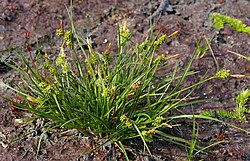Taxonomy
Carex viridula is in the section Carex sect. Ceratocystis, a circumboreal group with around six other species, although the taxonomy of this group is controversial, and up to 19 species have been recognized. [3] [4]
Flora of North America accepts the following three subspecies and two varieties of Carex viridula: [2] [5]
- Carex viridula subsp. brachyrrhyncha
- Carex viridula var. elatior
- Carex viridula var. saxilittoralis
- Carex viridula subsp. oedocarpa
- Carex viridula subsp. viridula
There is also variety Carex viridula var. bergrothii(Palmgr.) B.Schmid (synonym Carex bergrothiiPalmgr.). [6]
Kew's Plants of the World Online considers Carex viridula a synonym of Carex oederi , and accepts two varieties: [7]
- Carex oederi var. bergrothii(Palmgr.) Hedrén & Lassen
- Carex oederi var. oederi
This page is based on this
Wikipedia article Text is available under the
CC BY-SA 4.0 license; additional terms may apply.
Images, videos and audio are available under their respective licenses.

